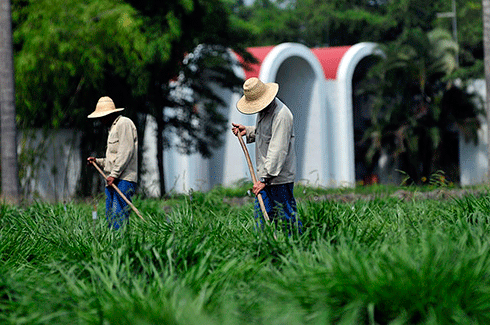
|
Published: 23 September 2013
Roots of grass for tropical livestock ‘plug’ greenhouse gas from soils
In a series of papers prepared for the recent International Grasslands Congress, scientists offered new evidence that a potent chemical mechanism operating in the roots of a tropical grass used for livestock feed has enormous potential to reduce greenhouse gas emissions.

|
|
Brachiara cultivation in Colombia. Credit:
CIAT via flickr
|
Referred to as ‘biological nitrification inhibition’ or BNI, the mechanism markedly reduces the conversion of nitrogen applied to soil as fertiliser into nitrous oxide.
Nitrous oxide is the most powerful and aggressive greenhouse gas, with a global warming potential 300 times that of carbon dioxide.
‘Nitrous oxide makes up about 38 per cent of all greenhouse gas emissions in agriculture, which accounts for almost a third of total emissions worldwide,’ said Michael Peters from the Colombia-based International Center for Tropical Agriculture (CIAT).
‘BNI offers what could be agriculture’s best bet for keeping global climate change within manageable limits.’
Scientists at CIAT and the Japan International Research Center for Agricultural Sciences (JIRCAS) have researched BNI collaboratively for the last 15 years.
‘This approach offers tremendous possibilities to reduce nitrous oxide emissions and the leaching of polluting nitrates into water supplies, while also raising crop yields through more efficient use of nitrogen fertilizer,’ said G.V. Subbarao, a senior scientist at JIRCAS.
Scientists say they have developed the means to exploit the BNI phenomenon on a large scale, for example:
-
CIAT researchers have found ways to increase BNI through plant breeding in different species of Brachiaria grasses. The new techniques include methods for rapidly quantifying BNI in Brachiaria together with molecular markers, which reduce the time needed for field testing.
-
Center scientists have also just gathered evidence that a maize crop grown after Brachiaria humidicola pastures gave acceptable yields with only half the amount of nitrogen fertiliser normally used, because more nitrogen was retained in the soil, thus reducing nitrous oxide emissions and nitrate leaching. Nitrogen-use efficiency was boosted by a factor of 3.8.
-
Scientists have also developed hybrids of Brachiaria humidicola that have been delivered to farmers in Colombia and Nicaragua for productivity and quality testing. Previous grass hybrids have increased milk and meat production by several orders of magnitude, compared to native savanna grasses, and by at least 30 per cent, compared to commercial grass cultivars.
‘Livestock production provides livelihoods for a billion people, but it also contributes about half of agriculture’s greenhouse gas emissions,’ Peters explained.
‘BNI is a rare triple-win technology that’s good for rural livelihoods as well as the global environment and climate. It defies the widespread notion that livestock are necessarily in the minus column of any food security and environmental calculation.’
‘About 70 per cent of the 150 million tons of nitrogen fertiliser applied globally is lost through nitrate leaching and nitrous oxide emissions; the lost fertiliser has an annual estimated value of US$90 billion,’ said Subbarao.
Grassland pastures are the single biggest use of agricultural land globally, covering 3.2 billion hectares out of a global total of 4.9 billion.
In Australia, nitrogen-based fertilisers are applied to about 32 million hectares of farmland, mostly in the form of ammonium phosphate or urea. The scientists say BNI technology could contribute to an
JIRCAS scientists discovered several years ago the chemical substance responsible for BNI and developed a reliable method for detecting the nitrification inhibitor coming from plant roots.
Scientists at CIAT then validated the BNI concept in the field, demonstrating that Brachiaria grass suppresses nitrification and nitrous oxide emissions, compared with soybean, which lacks this ability.
Other research has shown that deep-rooted, productive Brachiaria grasses capture large amounts of atmospheric carbon – on a scale similar to that of tropical forests – a further plus for climate change mitigation.
Source: International Grassland Congress



